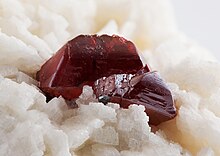Idria mine
| Idria mine | |||
|---|---|---|---|
| General information about the mine | |||
| Stollenmundloch the pit Idria, the secured with masonry crispness still leads water to light. | |||
| Information about the mining company | |||
| Start of operation | 1738 | ||
| End of operation | 1896 | ||
| Funded raw materials | |||
| Degradation of | mercury | ||
| Geographical location | |||
| Coordinates | 50 ° 58 '16.1 " N , 7 ° 9' 28.2" E | ||
|
|||
| Location | Bensberg | ||
| local community | Bergisch Gladbach | ||
| District ( NUTS3 ) | Rheinisch-Bergischer Kreis | ||
| country | State of North Rhine-Westphalia | ||
| Country | Germany | ||
| District | Bensberg ore district | ||
The Idria mine is a former non-ferrous metal ore mine in the Bensberg ore district in the Hardt nature reserve of Bergisch Gladbach . As the only mine in the entire area she was on mercury awarded . The site belongs to the Bensberg district . The main operating point was in the Milchborntal north of the bathing establishment.
history
Due to a general mortgage lending on mercury for the entire Duchy of Jülich and Berg on October 8, 1738, Hofrat Gumpertz opened “a mine near Bensberg” . It could only have been the Idria mine because it was the only mercury mine in the entire Bensberg ore district. Under the name "The hopeful luck" in 1764 Johann Peter Weck and Co. proposed on 22 December a Mutschein they received dated January 3, 1765th The investiture took place on their specific request on 15 April 1765 a treasure trove and 20 degree including Erbstollengerechtigkeit . On February 16, 1773, Johann Christian Welter had a certificate of courage issued for 20 units of the same mine and on May 1, 1773 for a further 10 units.
More than a hundred years later, on October 8, 1880 , the Bonn Oberbergamt again awarded the mine field for mercury, now with the name Idria. The name Idria goes back to the world-famous “Idrija” mercury deposit west of Ljubljana near the mining town of the same name, Idrija in Slovenia.
Operation and facilities
The records about the operation of the Idria mine deal with individual stages. The Weck & Comp. The company ran from 1765 to 1790. We are talking about mercury ores, which were found to be 1/4 to 1/2 inch thick in kidneys and nests . Mostly cinnabar was found , but also genuine mercury. The further processing took place in a hut in the Milchborntal, which was called "Laboratorium". From 1819 to 1824, experimental work was carried out at state expense. Among other things, they drove in search of a mineralized corridor of a 12 m deep die from a route southwards. Since there was no success, the experimental work was given up again. Further test work from 1894 to 1896 did not produce a satisfactory result either, so that all operations were subsequently stopped.
Notes on mercury
The mobility of mercury is so pronounced that corresponding accumulations can be measured both in the soil and in the air close to the ground. Even at normal temperature, especially at higher temperatures, mercury changes to a gaseous state. When the temperature drops, the condensate precipitates in the vicinity of ore veins in the distribution area of cinnabar deposits or zinc blende veins in the soil. When the Milchbornbach still ran in its natural bed, the elemental mercury also settled in the ponds as small globules that could be taken out with a spoon.
Ground monument

The entire Bensberg mercury mining area was entered on February 3, 1998 as soil monument no. 10 in the list of soil monuments in Bergisch Gladbach . For example, building work with foundations, digging pits, leveling, dumping or clearing trees are only permitted with prior approval from the Lower Monument Authority. The cinnabar crystals that occur here are highly valued by mineral collectors and have been found in the heap area up to a millimeter in size in recent times. The search for minerals in the subsoil is not allowed because it can lead to changes in the soil structure.
See also
Individual evidence
- ↑ a b c d Herbert Stahl (editor), Gerhard Geurts, Herbert Ommer: Das Erbe des Erzes. Volume 2, The pits on the Gangerz deposits in the Bensberg ore district . Cologne 2004, ISBN 3-00-014668-7 , pp. 88ff.
literature
- Emil Buff: Description of the Deutz mountain district. Marcus, Bonn 1882 (Unchanged reprint. (= Publication by the Friends of the Bergisches Museum for Mining, Crafts and Trades eV No. 1, ZDB -ID 2295238-X ). Friends of the Bergisches Museum for Mining, Trades and Trades, Bergisch Gladbach 1982) .
Web links
- Mineral Atlas - Fossil Atlas, Idria Pit Retrieved January 12, 2015

